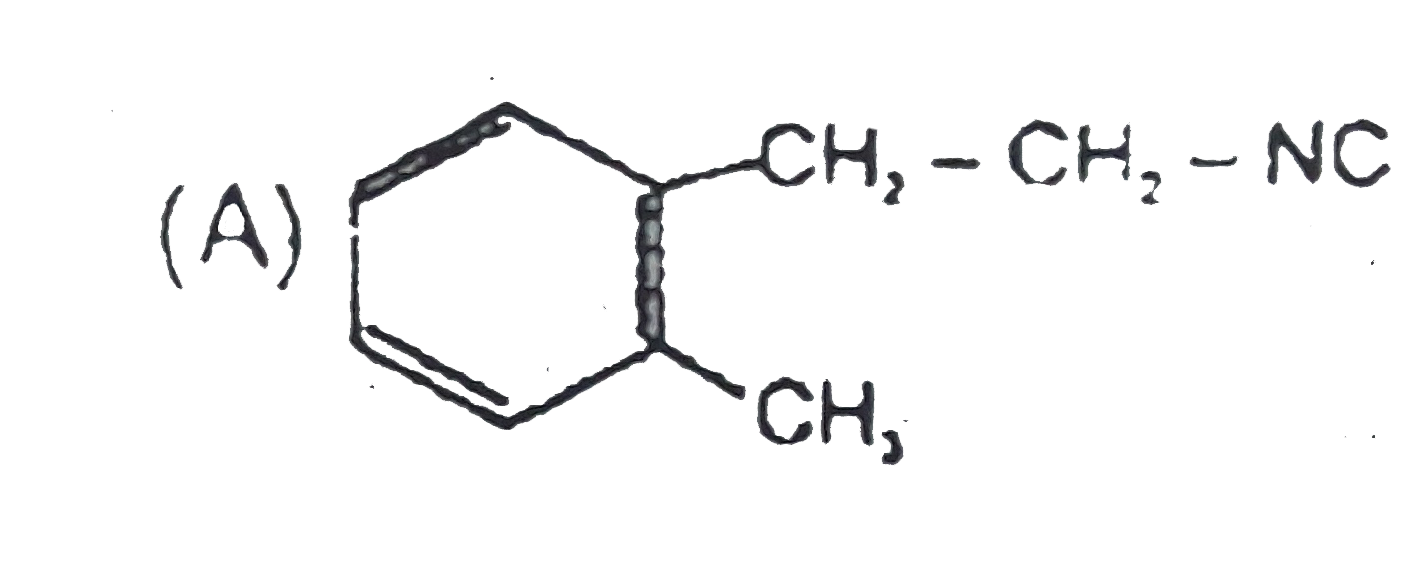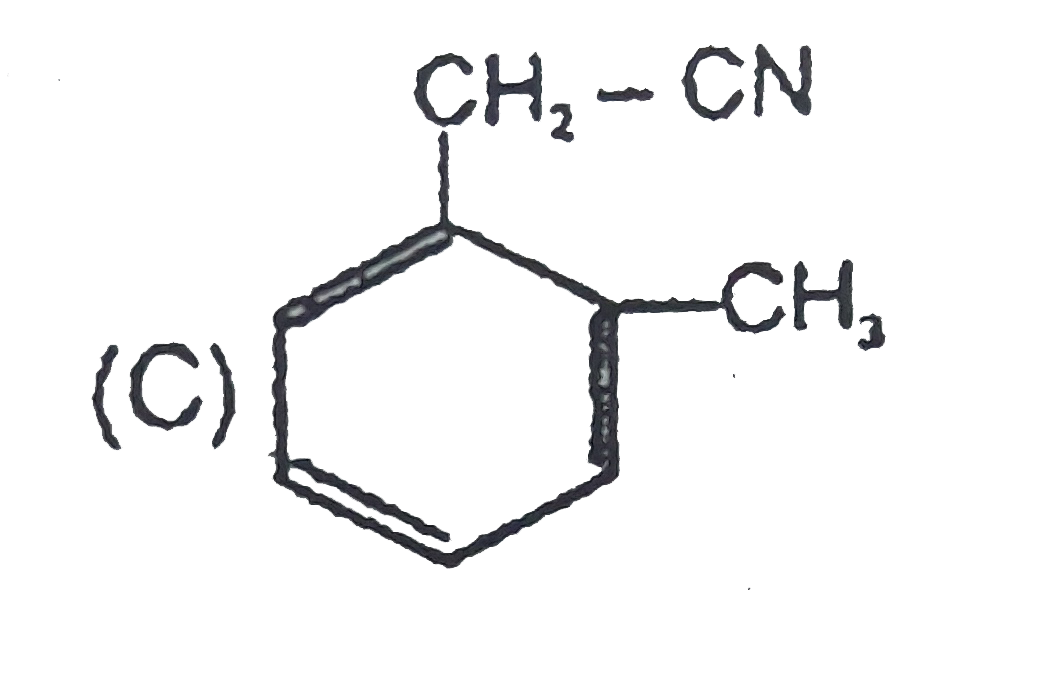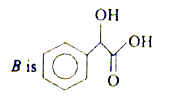The compound C8H9Cl(A) on treatments with KCN followed by hydrolysis gives C9H10O2(B).Ammonium salt of B on dry distillation yields C.Which reacts with alkaline solution of bromine to gives C8H11N.(D),Another compound E (C6H10O) is obtained by the action of nitrous acid on D. or by the action of aquouspotash on A,E on oxidation gives F(C8H10O) Which gives the inner anhydride G on heating.
The compound D is reaction with CHCl3+NaOH gives a compound H.The structure of H.




The correct Answer is:B
To solve the problem step-by-step, we will analyze the transformations of the compounds mentioned in the question.
Step 1: Identify Compound A
The compound A is given as C8H9Cl. This suggests that it is likely an aromatic compound with a chlorine substituent. A possible structure could be chlorobenzene with a side chain, such as C6H5−CH2Cl (benzyl chloride).
Step 2: Reaction of A with KCN
When compound A is treated with KCN, a nucleophilic substitution occurs where the chlorine atom is replaced by a cyanide group. This results in the formation of a compound with the formula C8H9CN.
Step 3: Hydrolysis of the Cyanide
Upon hydrolysis of the cyanide (C8H9CN), it converts to a carboxylic acid. The resulting compound B will have the formula C9H10O2, which can be represented as C6H5−CH2−COOH (benzoic acid derivative).
Step 4: Ammonium Salt of B
The ammonium salt of B can be formed by reacting B with ammonia. This results in the formation of an amide, which we will denote as compound C.
Step 5: Dry Distillation of Ammonium Salt
When the ammonium salt of B is subjected to dry distillation, it yields compound C. The structure of C is likely a simple amide derived from B.
Step 6: Reaction of C with Alkaline Bromine
Compound C reacts with an alkaline solution of bromine (Hofmann degradation), resulting in the formation of an amine, which we denote as D. The formula for D is C8H11N.
Step 7: Reaction of D with Nitrous Acid
When compound D reacts with nitrous acid (HNO2), it undergoes a reaction that replaces the amine group with a hydroxyl group, yielding compound E (C6H10O).
Step 8: Oxidation of E
Compound E is then oxidized to form compound F, which has the formula C8H10O. This compound can be represented as a dicarboxylic acid.
Step 9: Heating F to Form Anhydride G
Upon heating compound F, it forms an inner anhydride G. This is a cyclic structure formed from the carboxylic acid groups.
Step 10: Reaction of D with CHCl3 and NaOH
Finally, compound D reacts with CHCl3 and NaOH, which is known as the carbylamine reaction. This reaction converts the primary amine into an isocyanide (compound H).
Summary of Compounds
- A: C8H9Cl (Benzyl chloride)
- B: C9H10O2 (Carboxylic acid)
- C: Amide derived from B
- D: C8H11N (Amine)
- E: C6H10O (Alcohol)
- F: C8H10O (Dicarboxylic acid)
- G: Inner anhydride formed from F
- H: Isocyanide formed from D
The compound A is given as C8H9Cl. This suggests that it is likely an aromatic compound with a chlorine substituent. A possible structure could be chlorobenzene with a side chain, such as C6H5−CH2Cl (benzyl chloride).
When compound A is treated with KCN, a nucleophilic substitution occurs where the chlorine atom is replaced by a cyanide group. This results in the formation of a compound with the formula C8H9CN.
Upon hydrolysis of the cyanide (C8H9CN), it converts to a carboxylic acid. The resulting compound B will have the formula C9H10O2, which can be represented as C6H5−CH2−COOH (benzoic acid derivative).
The ammonium salt of B can be formed by reacting B with ammonia. This results in the formation of an amide, which we will denote as compound C.
When the ammonium salt of B is subjected to dry distillation, it yields compound C. The structure of C is likely a simple amide derived from B.
Compound C reacts with an alkaline solution of bromine (Hofmann degradation), resulting in the formation of an amine, which we denote as D. The formula for D is C8H11N.
When compound D reacts with nitrous acid (HNO2), it undergoes a reaction that replaces the amine group with a hydroxyl group, yielding compound E (C6H10O).
Compound E is then oxidized to form compound F, which has the formula C8H10O. This compound can be represented as a dicarboxylic acid.
Upon heating compound F, it forms an inner anhydride G. This is a cyclic structure formed from the carboxylic acid groups.
Finally, compound D reacts with CHCl3 and NaOH, which is known as the carbylamine reaction. This reaction converts the primary amine into an isocyanide (compound H).
- A: C8H9Cl (Benzyl chloride)
- B: C9H10O2 (Carboxylic acid)
- C: Amide derived from B
- D: C8H11N (Amine)
- E: C6H10O (Alcohol)
- F: C8H10O (Dicarboxylic acid)
- G: Inner anhydride formed from F
- H: Isocyanide formed from D
Topper's Solved these Questions
Similar Questions
The compound C8H9Cl(A) on treatments with KCN followed by hydrolysis gives C9H10O2(B).Ammonium salt of B on dry distillation yields C.Which reacts with alkaline solution of bromine to gives C8H11N.(D),Another compound E (C6H10O) is obtained by the action of nitrous acid on D. or by the action of aquouspotash on A,E on oxidation gives F(C8H10O) Which gives the inner anhydride G on heating. The compound D is reaction with CHCl3+NaOH gives a compound H.
The compound A on reaction with AgCN gives :
View SolutionThe compound C8H9Cl(A) on treatments with KCN followed by hydrolysis gives C9H10O2(B).Ammonium salt of B on dry distillation yields C.Which reacts with alkaline solution of bromine to gives C8H11N.(D)Another compound E is obtained by the action of nitrous acid on D. E on oxidation gives F which gives the inner anhydride G on heating. The Compound A is :
View Solution
Knowledge Check
Compound (A) C8H6O2 on treatment with aq. NaOH followed by acidification gives (B) C3H2O3 which on oxidation gives benzoic acid only:
A B
B C
C D
D
A compound (A) C5H10Cl2 on hydrolysis gives C5H10O which reacts with NH2OH, forms iodoform but does not give Fehling test (A) is :
AH3C−CI∣C∣CI−CH2CH2CH3BCH3CH2−CI∣C∣CI−CH2CH3CCI∣C∣CIHCH2CH2CH2CH3DCH3CH2CI∣CH−CI∣CHCH3
Compound (A) C8H9Br. Gives a white precipitate when warmed with alcoholic AgNO3. Oxidation of (A) gives an acid (B). C8H6O4. (B) easily forms anhydride on heating. Identify the compound (A)
View SolutionCompound (A) C8H9Br. Gives a white precipitate when warmed with alcoholic AgNO3. Oxidation of (A) gives an acid (B). C8H6O4. (B) easily forms anhydride on heating. Identify the compound (A)
View SolutionAcetoisonitrile on reaction with C2H5MgBr followed by hydrolysis, gives compound (A), which one further hydrolysis gives (B) and (C).
(B) and (C) are :
View SolutionA compound D(C8H10O) upon treatement with alkaline solution of iodine gives a yellow precipitate. The fibtrate on acidification gives a white solid E(C7H6O2). Write the structures of D,E .
View SolutionBoron reacts with oxygen at 700∘C to give (A). Compound (A) reacts with carbon and dry chloride to give (B) and carbon monoxide. (B) on reduction with LiAlH4 gives (C) along with LiCl and AlCl3.(C) on reaction with ammonia gives (D). Which on heating gives (E).(C) on reaction with NaH gives (F).
Compound (A) is
View SolutionAn organic compound (A)(C5H8O3) on heating with soda lime gives (B) which reacts with HCN to give (C). The compound (C) reacts with thionyl chloride to produce (D) which on reaction with KCN gives a compound (E). Alkaline hydrolysis of (E) gives a salt (F) which on heating with soda lime produces n−butane. Careful oxidation of (A) with dichromate give acetic acid and malonic acid. Give the structures to (A) to (F) with proper reasoning.
View Solution

